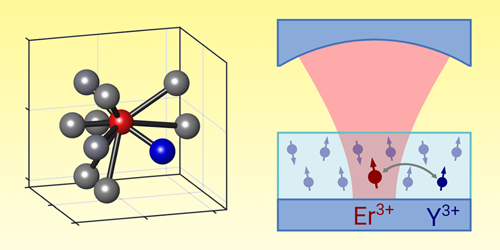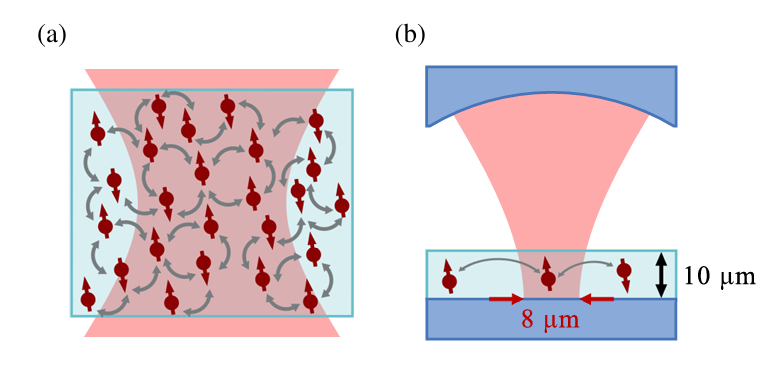
Scientists have been studying tiny magnetic bits inside solids called spins. These spins are important because they could be the building blocks for future technologies that use quantum physics, like super-secure communication or super-fast computers.
But it is not that straightforward, these spins don’t live alone. Around each spin, there are other tiny other magnets inside the atoms nearby. These neighbors affect the spin and make it hard to keep information stable for long. This problem is called “superhyperfine interaction”, which means that the tiny magnetic spins around each other get in each other’s way and cause some confusion.
Sometimes, scientists try to fix this by cleaning up the material to remove some of those interfering atoms but the process isn’t that efficient.
The research on Cavity-Enhanced Spectroscopy of Individual Nuclear Spins in a Dense Bath was carried out through a collaboration between scientists from the Technical University of Munich (TUM), School of Natural Sciences, Physics Department, and the Munich Center for Quantum Science and Technology (MCQST), James-Franck-Straße 1, D-85748 Garching, Germany, as well as the Max-Planck-Institut für Quantenoptik, Quantum Networks Group, Hans-Kopfermann-Straße 1, D-85748 Garching, Germany. This partnership brought together expertise in quantum physics and advanced spectroscopy techniques to achieve the breakthrough in isolating and understanding individual spins within a dense environment.

Untangling the Spin Crowd
As per the scientists, if they could figure out a way to control them, they could actually be used to store information themselves, like little pockets holding data.
The issue is, these neighbors are often placed very close to each other, making it hard to tell one from the other. It’s like trying to listen to just one person talking in a noisy room where everyone is speaking at the same time. Older techniques could only identify spins that were very different from the others, but when many spins sound alike, it becomes really difficult to tell them apart.
Listening to Atoms with Light
To do the research, the team studied a material with tiny erbium atoms embedded in a crystal. Erbium is useful because it gives off light at the same wavelengths used in internet and phone networks. But the surrounding atoms interfere, making it hard to isolate and study the behavior of each individual erbium atom, their signals tend to blur together.
To solve this, the scientists used a method where they send pulses of light to make the spins “echo”, quite like shouting in a cave and listening for the echo to learn about the space. This echo changes in a way that depends on the neighboring spins, thus, giving clues about them.
Before, this echo method worked well only on large groups of atoms, so they couldn’t zoom in on individual spins.
What these scientists did differently was put their sample inside a tiny mirror chamber that traps light and makes the signals much stronger. This allowed them to work with fewer erbium atoms and get clearer signals. Since there were fewer atoms, the spins didn’t interfere with each other as much, and the information lasted longer.
When Spins Feel Their Surroundings
With this setup, they could tell apart spins that were very similar, like hearing faint whispers in a quiet room. They also focused on individual erbium atoms instead of large groups. They found that when other tiny impurities were nearby, the spins behaved differently, showing that small local changes in the crystal can influence how the spins act. It’s like how a river’s flow changes when it encounters hidden rocks beneath the surface. This shows that even minor imperfections in the crystal could nudge the spins in new directions, just as small terrain shifts can steer the course of a winding path.

Clearing the Noise in Quantum Crystals
The main way to identify individual spins was by how the magnetic properties of erbium atoms change when they are energized by light. This change slightly alters the magnetic surroundings of nearby atoms, causing their spins to wobble in a specific way that creates a recognizable pattern in the signal. Since this magnetic effect depends on the exact position of each nearby atom, scientists could focus on signals from single atoms by fine-tuning an external magnetic field.
In short, by combining this light echo method with a tiny mirror chamber, they finally managed to see individual spins in a very crowded environment. This helps scientists understand how spins interact with their neighbors and could lead to better quantum technologies where these spins store and process information.
Takeaway
This research has a lot of promise because being able to handle individual atomic spins means each spin could serve as a tiny unit of quantum information. This could lead to very small, high-capacity storage systems where information is kept at the atomic level, making electronic devices faster, more powerful, and energy-efficient.
Also, learning how to manage how tiny particles’ spins interact in crowded spaces helps us develop larger, more reliable quantum computers. This progress brings us closer to building powerful machines that can tackle problems regular computers can’t handle.
If we can now listen to single atomic whispers in a crowded room, what new conversations in quantum science are we finally ready to hear?
Source: Physics Magazine



